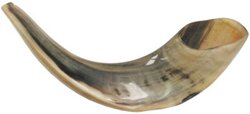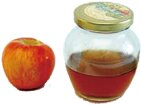| The meaning of Rosh Hashanah |

|

|
|
...In the seventh month, on the first of the month, there shall be a sabbath for you, a remembrance with shofar blasts, a holy convocation. - Leviticus 16:24 Rosh Hashanah occurs on the first and second days of Tishrei. In Hebrew, Rosh Hashanah means, literally, “head of the year†or “first of the year.†Rosh Hashanah is commonly known as the Jewish New Year. The Jewish New Year is a time to begin introspection, looking back at the mistakes of the past year and planning the changes to make in the new year. The name “Rosh Hashanah†is not used in the Bible to discuss this holiday. The Bible refers to the holiday as Yom Ha- Zikkaron (the day of remembrance) or Yom Teruah (the day of the sounding of the shofar). The holiday is instituted in Leviticus 23:24-25.
The shofar is a ram's horn which is blown somewhat like a trumpet. One of the most important observances of this holiday is hearing the sounding of the shofar in the synagogue. A total of 100 notes are sounded each day. There are four different types of shofar notes: tekiah, a 3 second sustained note; shevarim, three 1-second notes rising in tone, teruah, a series of short, staccato notes extending over a period of about 3 seconds; and tekiah gedolah (literally, “big tekiahâ€), the fi nal blast in a set, which lasts (I think) 10 seconds minimum. One that has been suggested is that the shofar's sound is a call to repentance. The shofar is not blown if the holiday falls on Shabbat. No work is permitted on Rosh Hashanah. Much of the day is spent in synagogue, where the regular daily liturgy is somewhat expanded. In fact, there is a special prayerbook called the machzor used for Rosh Hashanah and Yom Kippur because of the extensive liturgical changes for these holidays. Another popular observance during this holiday is eating apples dipped in honey, a symbol of our wish for a sweet new year. We also dip bread in honey (instead of the usual practice of sprinkling salt on it) at this time of year for the same reason.
We eat other foods that symbolise good things we hope for in the coming year. We contemplate what these foods symbolise, and connect with the source of all good things. The symbolic foods are based on a word game which connects the name of a certain food, to a particular hope we have for the new year. Here is a list from the Talmud customarily eaten on Rosh Hashanah: • Leek or cabbage Another popular practice of the holiday is Tashlikh (“casting offâ€). We walk to flowing water, such as a creek or river, on the afternoon of the first day and empty our pockets into the river, symbolically casting off our sins. Small pieces of bread are commonly put in the pocket to cast off. This practice is not discussed in the Bible, but is a long-standing custom. Tashlikh is normally observed on the afternoon of the fi rst day, before afternoon services. When the first day occurs on Shabbat, many synagogues observe Tashlikh on Sunday afternoon, to avoid carrying (the bread) on Shabbat. Religious services for the holiday focus on the concept of G-d's sovereignty. The common greeting at this time is L'shanah tovah (“for a good yearâ€). This is a shortening of “L'shanah tovah tikatev v'taihatem†(or to women, “L'shanah tovah tikatevi v'taihatemiâ€), which means “May you be inscribed and sealed for a good year.†(Issue September 2009)
|



















